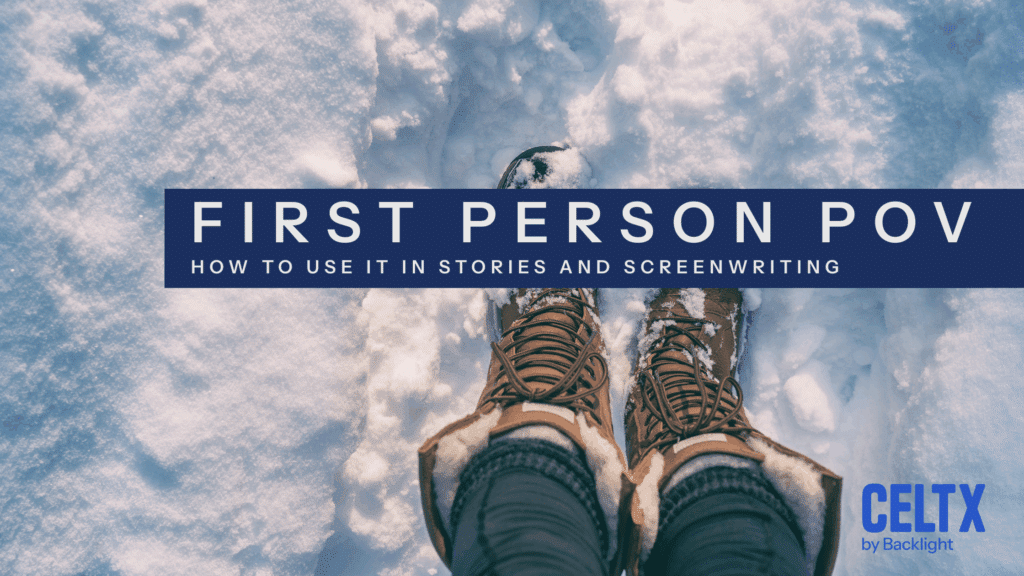
Point of view is one of the most important aspects of storytelling. It determines how the audiences experience the story world, the events and the characters within it.
First person point of view (POV) immerses the reader or viewer directly into the perspective of a character to convey a personal and often emotional lens.
Kinda selfish really, but it’s an effective way to tell stories. From classic literature to modern movies, first person POV has drawn in audiences for hundreds of years.
But how is it used? How can we adopt it in our own writing to engage our audience? Well, in today’s edition of the Celtx blog, we’ll explore how to use first person POV in your stories and screenplays. As usual, we’ll include examples from the experts and practical tools to get you started.
So, from our point of view, we’re ready to start the blog. Are you?
Table of Contents
- What is First Person POV
- How First Person Works in Writing
- Examples in Novels
- First Person in Film and TV
- POV Shots vs. First Person Narration
- When Do I Use First Person POV?
- Tools for Crafting Voice
- FAQ
- Conclusion

What is First Person POV?
First person point of view is a narrative mode where the story is told from the perspective of a character directly involved in the events.
For this perspective, the narrator uses first person pronouns like I, me, my, and we. The use of these pronouns creates a familiarity with the audience, almost like a direct conversation.
First person POV can be used slightly differently depending on whether you’re writing prose or a screenplay. In literature, it forges an immediate connection with the reader, while in screenwriting, voice over or visual techniques can communicate first person POV.
Who is this first-person narrator? Well, they could be the protagonist, an observer, or even a reliable narrator. No matter who they are, exploring only one person’s perspective on events gives a sense of ambiguity and intrigue.
Of course, when you’re only hearing one side of the story, biases and limited knowledge can play a part. But that’s what makes things exciting!
How First Person Works in Writing
First person POV is the ideal perspective to write from when you want to:
- Take a deep dive into a character’s thoughts, feelings and views.
- Create a distinctive voice that reflects the narrator’s personality.
- Limit the narrative to what the narrator experiences and knows to create a great sense of dramatic irony and suspense.
While it can be very tempting to reveal everything the POV character is thinking and feeling, it’s important that writers using first person POV carefully balances what is said and what remains concealed.
The beauty of an unreliable first-person narrator is their opinions and emotions can add color to every single story events, affecting how the audience interprets both what happens and the motivations of other characters.

Examples in Novels
Before we dive into how first person POV is adopted for movies and TV shows, let’s look at some of the classic uses in literature.
Case Study #1 | The Catcher in the Rye J.D. Salinger (1951)
Protagonist Holden Caulfield’s narration is a masterclass in character voice. His cynical and sarcastic, yet deeply vulnerable tone runs through the entire novel. The reader sees the world entirely through his eyes, with his unique emotional and psychological filters.
When you’re dead, they really fix you up. I hope to hell when I do die somebody has sense enough to just dump me in the river or something. Anything except sticking me in a goddam cemetery. People coming and putting a bunch of flowers on your stomach on Sunday, and all that crap. Who wants flowers when you’re dead? Nobody. – Catcher in the Rye (1951) – J.D. Salinger
Case Study #2 | The Hunger Games Suzanne Collins (2008)
Katniss Everdeen’s first-person account of the events in District 12 and beyond, bringing immediacy and urgency to the dystopian world in which she exists. Her thoughts provide both context to the world-building as well as reveals her inner struggles.
It’s her account that raises the emotional stakes of the world and makes sure we’re bought in as readers.
“You’re not leaving me here alone,” I say. Because if he dies, I’ll never go home, not really. I’ll spend the rest of my life in this arena, trying to think my way out. – The Hunger Games (2008) – Suzanne Collins
Case Study #3 | The Handmaid’s Tale Margaret Atwood (1985)
Offred’s first person narration blends internal reflection with external observation of the totalitarian regime she lives under.
Her voice shifts between resistance, reservation and remembrance which draws the reader into her psychological conflict and survival instinct.
We were the people who were not in the papers. We lived in the blank white spaces at the edges of print. It gave us more freedom.
We lived in the gaps between the stories. – The Handmaid’s Tale (1985) – Margaret Atwood

Transform your screenplay with Celtx—screenwriting software that helps you write, format, and fine-tune your story.
Get started today (it’s free!)
First Person in Film and TV
Okay, so we know this is what you’re all here for… the film and TV examples. While literature has led the way in terms of first-person narration, visual media has never been far behind.
Here are our top picks of first-person narratives in some of the best movies and shows in recent years.
Case Study #4 | Fleabag (2016-2019)
Writer and actress Phoebe Waller-Bridge’s character frequently breaks the fourth wall in this hilarious series and speaks directly to the audience. This creates a pseudo-first person narrative which builds intimacy with us and reveals her inner thoughts and state in real-time.
It’s extremely relatable, reflecting how we may feel in sometimes bizarre yet very real situations.
Case Study #5 | Dexter (2006-2013)
Dexter Morgan’s voice over narration gives us a deep insight into his dark thoughts and double life. While his actions are violent and morally questionable a lot of the time, it’s this first-person perspective that allows us to empathize with him as an audience.
Case Study #6 | Mr. Robot (2015-2019)
In this case, the audience is Elliot Anderson’s imaginary friend who he speaks to through voice over.
This unique storytelling technique creates both a disorienting but compelling first-person perspective that aligns with the show’s themes of mental illness and reality distortion.
Case Study #7 | Goodfellas (1990)
Henry Hill narrates his rise and fall in the world of organized crime. His voice over guides us through his personal experiences and justification for his actions. It almost adds a novelistic feel to the movie, which suits the 1955 time period.
POV Shots vs. First Person Narration
So, what happens when we see a scene through a character’s eyes in a movie or TV show, does this count as first-person narration?
Not exactly. POV shots like this are visual techniques where the camera mimic’s a character’s direct line of sight. Yes, this does immerse us in the action and a character arc through a particular person’s eyes, however it’s not the same as first person narration.
True first-person storytelling in film involves the character’s inner voice speaking and guiding us through the narrative.
For example, in a horror movie, a POV shot may show the world from the murderer’s eyes. However, unless we hear their thoughts or narration accompanying the visuals, it’s not true first person. The narration is what adds the emotional depth and context we need.
When Do I Use First Person POV?
Like many literary techniques, there’s always a time and a place to use first person POV in screenwriting. We’ve already explored why writers may need to use it in their work, however, here are four more instances where first person POV works:
- The emotional or psychological experience of a character is central to the story.
- You wish to build a deep personal connection between character and audience.
- Your story will benefit from a unique or unreliable perspective.
- You’re telling a coming-of-age, memoir-style, or confessional story.
In essence, we recommend you use first person POV when your protagonist’s inner voice is vital to understanding the overall plot, or when it adds a dimension that simply cannot be shown visually.
There are benefits and drawbacks to first person POV. Let’s explore them:
Benefits to First Person POV
- First person POV adds emotional depth and connects the audience intimately to the narrator.
- The unique voice allows for highly stylized and personal storytelling.
- The subjectivity of this POV allows the author to manipulate reader perceptions.
- First person POV can be used to create an unreliable narrator creating twists, ambiguity, and intrigue.
Drawbacks to First Person POV
- The POV provides a limited perspective to only what the narrator knows or experiences.
- It requires a careful maintenance of the narrator’s voice throughout the story.
- With only one perspective, things can easily become tedious, so the voice needs variation.
- First person is one of the most challenging perspectives to get right in screenwriting. It needs to be used both sparingly and creatively to avoid overwhelming the visuals.
Tools for Crafting Voice
We’d love to say that crafting a compelling first-person voice requires you just to switch the pronouns around, but it’s not.
But fear not, as there are some tools and methods you can use to write a kick-ass first- person perspective.
1. Write Voice Journals
Write diary entries from your character’s perspective as part of your planning process. Add it to your character’s profile and really explore who they are, what they like and dislike as well as their moral code.
Of course, these entries won’t always make it into the script, but as the writer, you need as much background as possible to genuinely inform their actions and thoughts as you write.

2. Monologues
Like diary entries, use inner monologues to explore the characters state of mind, but this time during particular scenes and key plot points. Again, this doesn’t have to make it into the script itself but informs your process.
3. Dialogue Exercises
Branch out from your protagonist’s inner monologue and have them converse with other characters in your story world. This could be away from the narrative itself or different options of exchanges within scenes.
Remember, subtext and visual cues are still your best friend when it comes to evoking emotions. Show don’t tell!

4. Celtx
With all this writing, you’re going to need screenwriting software to help organize your ideas and outlines. Here at Celtx, we help to streamline the process of layering narration into a screenplay while maintaining pacing.
Alongside Celtx’s standout scriptwriting features, their tools allow you to add voice over lines, internal dialogue as well as notes to visualize how the narration fits into the scene structure.
Our formatting tools also help you to distinguish voice over from dialogue and action, always keeping your script clear and to industry standard.
Check out how we can help you with formatting your next script here.
FAQ
What’s the difference between first and third person?
First person uses I and reflects the character’s inner voice. On the other hand, third person uses he, she, or they and can be limited to one character’s perspective or omniscient.
First person is more intimate but limited while third person offers more flexibility.
Can you have multiple types of narration in one story?
Yes, you can! Many novels and films alternate between first and third person, or between different characters’ first-person accounts. However, if you’re going to try this, you should plan carefully to avoid confusing the audience.
Should I use first person for my screenplay?
You should only use first person perspective if it adds something essential to the experience. If you overuse voiceover, it can come off as lazy exposition unless it’s stylistically justified.
Conclusion
First person POV is a powerful storytelling device when used with intention and skill. Whether you’re writing a novel or a screenplay, it offers a direct line to the character’s soul and invites the audience into their fears, desires, and worldviews.
However, it requires careful handling to maintain voice, avoid limitations, and integrate smoothly into your narrative structure.
Explore the possibilities, test different voices, and consider tools like Celtx to organize and shape your story. With the right approach, first person POV can transform your writing into an immersive, unforgettable experience.
Up Next:

What is Third Person Point of View in Writing? Definition & Examples
Elevate your storytelling prowess with the guidance of third-person point of view, illustrated through compelling examples.
More tools to develop your story:
- How to Use Personification (With Film & TV Examples)
- The Inciting Incident: 5 Steps to Hook Audiences from the Start
- The Climax: How to Write the Moment That Changes Everything
